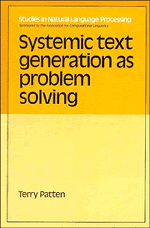Book contents
- Frontmatter
- Contents
- Dedication
- Preface
- 1 Introduction
- 2 Background I: AI problem solving
- 3 Background II: systemic grammar
- 4 The conflation
- 5 The formal model
- 6 The implementation
- 7 Related work in text generation
- 8 Conclusions
- Appendix A OPS5 tutorial
- Appendix B Sample texts
- Appendix C Excerpts from the grammar
- Notes
- Bibliography
- Index
- Frontmatter
- Contents
- Dedication
- Preface
- 1 Introduction
- 2 Background I: AI problem solving
- 3 Background II: systemic grammar
- 4 The conflation
- 5 The formal model
- 6 The implementation
- 7 Related work in text generation
- 8 Conclusions
- Appendix A OPS5 tutorial
- Appendix B Sample texts
- Appendix C Excerpts from the grammar
- Notes
- Bibliography
- Index
Summary
This final chapter consists of four parts. First, the main points from the previous chapters will be summarized, giving a condensed description of the work done on the SLANG approach to text generation. Second, the problems that may impede progress on SLANG will be examined. Third, some ideas for future research will be explored. Fourth, the concluding remarks will include an evaluation of SLANG and the current progress, and the prospects for the future.
Summary
The problem
One problem that has persistently occupied and bedevilled text-generation research is how to interface higher-level reasoning with an explicit grammar written in an established linguistic formalism. This problem is central to text generation because of the computational and linguistic requirements of the task.
Text generation involves an enormous, complex search space, yet must be performed quickly if it is to be effective. These characteristics suggest that text generation requires the powerful knowledge-based computational methods–such as forward-chaining and goal-directed backward-chaining–developed in AI over the past fifteen years.
Text generation also has important linguistic requirements. Specifically, an explicit grammar that is represented in an established linguistic formalism is required. This enables direct input from linguists and the linguistic literature. It also allows the grammar to be understood, judged, modified and so on, independently of the computational concerns (Appelt, 1982). Finally, assuming that the processing is guided by the explicit grammar, the grammar can provide a useful display of the logical structure of the text-generation process.
The problem of interfacing the AI problem-solving techniques with the linguistic formalism arises because of the apparent incompatibility of the representations involved.
- Type
- Chapter
- Information
- Systemic Text Generation as Problem Solving , pp. 146 - 156Publisher: Cambridge University PressPrint publication year: 1988

